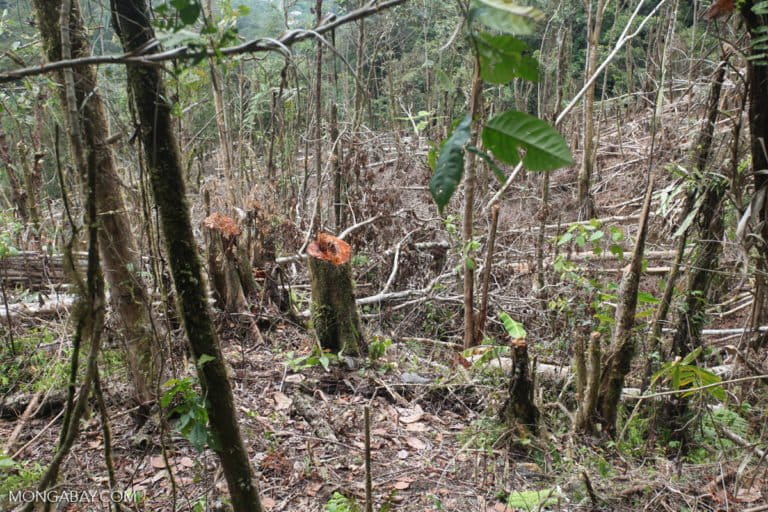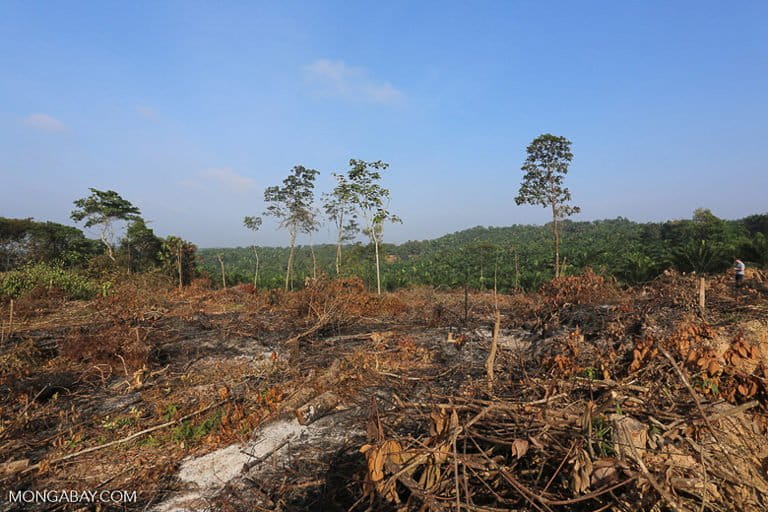- Curbing deforestation associated with the palm oil industry is crucial if Indonesia wants to meet its long-term emissions reduction targets, experts say.
- There are still 3.5 million hectares (8.65 million acres) of natural forest inside existing oil palm concessions that could potentially be cleared in as little as three years as demand for palm oil continues to grow.
- Experts have called on the government to save these forests by extending and strengthening a moratorium on licensing new plantations.
- They also call for the adoption of the high conservation value and high carbon stock approaches to identifying areas to protect.
JAKARTA — Indonesia could lose an area of tropical rainforest bigger than Belgium to oil palm plantations over the next three years without existing measures to slow this loss, activists warn. This would negate the government’s own commitment to achieve net-zero carbon emissions by 2070.
Indonesia has since 2018 banned the issuance of permits for new oil palm plantations to stem deforestation associated with palm oil production. But existing concessions containing vast swaths of forest may still be cleared. These amount to 3.5 million hectares (8.65 million acres) of forest — and they could be cleared within just three years, according to Anggalia Putri, forest and climate program director at the environmental NGO Madani.
She notes that companies are required to develop their concessions within three years or risk having the land deemed as “abandoned,” seized by the state and given to another firm under existing regulations.
“So oil palm trees have to be planted and the natural forests [in the concessions] will disappear,” Anggalia told Mongabay.
Besides that, the government’s biodiesel program, which seeks to phase out fossil fuel diesel for a blend that contains palm oil-derived fuel, also threatens deforestation, she added. Indonesia’s biodiesel transition program, the world’s most ambitious, will require 15 million hectares (37 million acres) — an area a fifth the size of Borneo — of new oil palm plantations, according to the government.
While it’s not clear whether the new plantations will be established in already deforested areas, the program nevertheless adds further pressure to clear natural forests inside existing oil palm concessions, Anggalia said.
“Various studies show that if the demand for biofuel increases overtime, we will run out of crude palm oil by 2023 or 2024,” she said. “And of course that’s an immense pressure for our natural forests and peatland. If we clear all natural forests [inside concessions] for biofuel [production], we will miss the target” set by Indonesia’s government of turning the country’s tropical forests back into a carbon sink by 2030.
That target is part of a larger goal to achieve net-zero carbon emissions by 2070; both aims have been derided as massively unrealistic by experts and activists.

No review, no revocation
Most of Indonesia’s remaining primary forests are located in the easternmost region of Papua, made up of the administrative provinces of Papua and West Papua.
In West Papua province, a government review recently identified 383,431 hectares (947,479 acres) — an area two and a half times the size of London — of intact forest that sits inside areas earmarked for oil palm plantations.
While there hasn’t been a similar review in the neighboring, and much larger, Papua province, a new report by Greenpeace shows at least 685,388 hectares (1.69 million acres) of forests inside oil palm concessions. Nearly two-thirds constitutes primary forest and almost a sixth is peatland.
Primary and peat forests are ostensibly protected under the palm oil permit moratorium, but the policy isn’t retroactively applicable for concessions issued before it was passed. And without extra measures to protect these forests, they can be legally cleared for planting oil palms.
Greenpeace estimates that clearing this area of forest in Papua province could release 71.2 million metric tons of carbon — equivalent to almost half of Indonesia’s total emissions in 2018, or half the emissions from the global aviation industry that same year.
Greenpeace says the figure is a conservative one as it doesn’t account for the carbon stored in below-ground biomass such as peat. That makes preserving these forests a crucial part of achieving any kind of long-term carbon sink or net-zero goals, according to Greenpeace forest campaigner Arie Rompas.
“If this is done immediately by revoking existing permits, the Indonesian government could save the carbon remaining in Papua’s concessions,” he said. “If it’s not done, of course the 2070 net-zero emissions target won’t be achieved.”

Weak policies
Experts say there have already policies in place that could potentially prevent these forests from being cleared. But they’re either not strong enough or aren’t being strictly implemented.
The 2018 oil palm permit moratorium is itself a case in point. In addition to halting the issuance of licenses for new plantations, it also calls for a sweeping review of existing licenses. But according to Greenpeace, not a single permit has been revoked as part of this process, even though many were issued in apparent violation of prevailing laws and regulations.
And even if a concession is found to be illegal, there’s no default mechanism to redesignate the land as forest, allowing local governments to easily parcel the land back out to another company under a new permit.
The Ministry of Environment and Forestry says it’s addressing this issue.
“We’re currently discussing a ministerial regulation on how to revoke permits that have already been issued,” Ruandha Agung Sugardiman, the ministry’s acting chief of planning, said at a March 22 press conference. “The point is we protect our primary forests so that our national target of reducing emissions by curbing deforestation [can be met].”
Compounding the lack of permit reviews is the fact that the moratorium expires in September this year. Without an extension, the previously unbridled issuance of palm oil licenses will resume, which would put even greater pressure on natural forests, according to Jasmine Puteri, the Indonesia program advisor at the NGO Rainforest Foundation Norway (RFN).
Trias Fetra, a palm oil management program officer at Madani, said extending the moratorium alone is not enough. The government also needs to strengthen it by including a stipulation that explicitly bans clearing natural forests and peatland inside existing concessions, he added.
“That’s why continuing the oil palm moratorium policy with an element of saving natural forest and increasing the productivity of oil palm plantations is very important in achieving Indonesia’s long-term vision,” Trias said.

High conservation value and high carbon stock
An important aspect of identifying forests to save is by determining which areas have high conservation value (HCV) and/or high carbon stock (HCS), and then designating them as protected from clearing.
In 2020, Environment and Forestry Minister Siti Nurbaya said her office had identified nearly 1.5 million hectares (3.7 million acres) of potential HCV areas within 345 oil palm concessions with a total area of nearly 3.6 million hectares (8.9 million acres).
Rizaldi Boer, director of the Center for Climate Risk and Opportunity Management in Southeast Asia and Pacific at the Bogor Institute of Agriculture (IPB), said the government had started discussing taking the HCV and HCS approach in payment ecosystem services. This would see incentives offered to farmers or landowners in exchange for managing their land to provide ecological service.
“The problem is that the regulation on this matter hasn’t been issued yet,” Rizaldi said.
If the HCV and HCS concepts are applied in identifying areas with high ecosystem services, then large swaths of forest can be saved from deforestation, given that more than 60% of industrial and oil palm plantations have high ecosystem services, Rizaldi added.
“Right now, it’s still voluntary” for landowners to implement the HCV and HCS concept, he said.
Rizaldi cited the Roundtable on Sustainable Palm Oil (RSPO) as an example of certification scheme that requires its members to adopt the HCV and HCS approach. The RSPO, widely considered the gold standard for palm oil sustainability certification, requires plantings after November 2005 to not replace primary forest or areas required for management to maintain HCV forests. In November 2018, the RSPO started requiring its members to conserve HCS forests as well.
“Those who have become RSPO members wouldn’t dare to clear forests inside their concessions. If palm oil plantations that are established after 2005 cause deforestation, [the companies] will have to pay for remediation and penalties,” Rizaldi said.
Indonesia also has its own domestic sustainability certification scheme, called the ISPO. Unlike the RSPO, which is voluntary, the Indonesian government has made the ISPO compliance mandatory for all growers. But while the ISPO states that HCV areas cannot be cleared and HCV identification is required, it doesn’t define the identification procedures clearly and is based on national laws and regulations that don’t recognize the HCV concept and don’t make it mandatory to conduct HCV assessments before clearing a forested area.
The ISPO also hasn’t adopted the HCS approach.
“That’s why I emphasize that this certification policy [ISPO] has to include this element [HCV/HCS] as well, and it’s a mandatory element,” Rizaldi said.
The environment ministry’s Ruandha said the ministry has a high-resolution map showing which concessions have HCV and HCS forests.
“But the ones who determine whether an area is HCV or HCS is the license holder,” he said. “What will the management [of the HCV/HCS area] be like? Will it be managed by the license holder itself, or returned to the government? That’s [determined] case by case.”
Banner image: Oil palm plantations in Malaysia. Image by Rhett A. Butler / Mongabay.
FEEDBACK: Use this form to send a message to the author of this post. If you want to post a public comment, you can do that at the bottom of the page.
